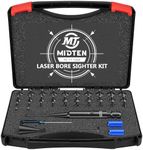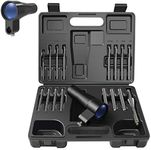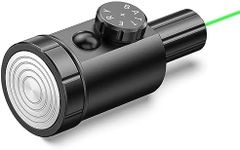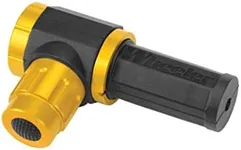Buying Guide for the Best Laser Bore Sighters
Choosing a laser bore sighter is all about making the process of sighting in your firearm faster, easier, and more accurate. A bore sighter projects a laser beam from the barrel, helping you align your sights or scope with the bore of your gun before you start live firing. This saves time, ammunition, and frustration. When picking a laser bore sighter, it's important to consider how it fits your firearm, how visible the laser is, and how easy it is to use. Understanding the key specifications will help you select the right tool for your needs.Caliber CompatibilityCaliber compatibility refers to the range of firearm calibers that the bore sighter can fit. Some bore sighters are designed for a specific caliber, while others come with adapters to fit multiple calibers. This is important because using the wrong size can result in inaccurate alignment or even damage. If you own several firearms in different calibers, a universal or multi-caliber bore sighter is more versatile. If you only have one firearm, a caliber-specific model may be simpler and more precise.
Laser Wavelength and VisibilityThe laser wavelength, usually measured in nanometers (nm), determines the color and visibility of the laser dot. Red lasers (around 630-670nm) are common and work well indoors or in low light, while green lasers (around 520-532nm) are brighter and more visible in daylight. If you plan to use the bore sighter outdoors or in bright conditions, a green laser may be easier to see. For indoor use or low-light environments, a red laser is usually sufficient.
Power Source and Battery LifeLaser bore sighters are powered by batteries, and battery life can vary depending on the type and quality of the sighter. Some use common button cell batteries, while others use rechargeable options. Longer battery life means you can spend more time aligning your sights without interruptions. If you expect to use the bore sighter frequently or for multiple firearms in one session, look for models with longer battery life or easy battery replacement.
Mounting MethodThe mounting method describes how the bore sighter attaches to your firearm. There are two main types: chamber-inserted and muzzle-inserted. Chamber-inserted models fit into the chamber like a cartridge, while muzzle-inserted models fit into the end of the barrel. Chamber-inserted sighters are often more precise for specific calibers, while muzzle-inserted types can be more versatile for different calibers. Your choice depends on your preference for convenience versus precision, and the types of firearms you own.
Durability and Build QualityDurability refers to how well the bore sighter can withstand repeated use and handling. Look for models made from sturdy materials like brass or aluminum, as these are less likely to get damaged or misaligned. If you plan to use the bore sighter often or in different environments, a robust build will ensure it lasts longer and maintains accuracy.
Ease of UseEase of use covers how simple it is to set up and operate the bore sighter. Features like clear instructions, easy battery installation, and straightforward mounting make the process smoother, especially for beginners. If you’re new to bore sighting, look for models with user-friendly designs and good customer support or instructional materials.


















